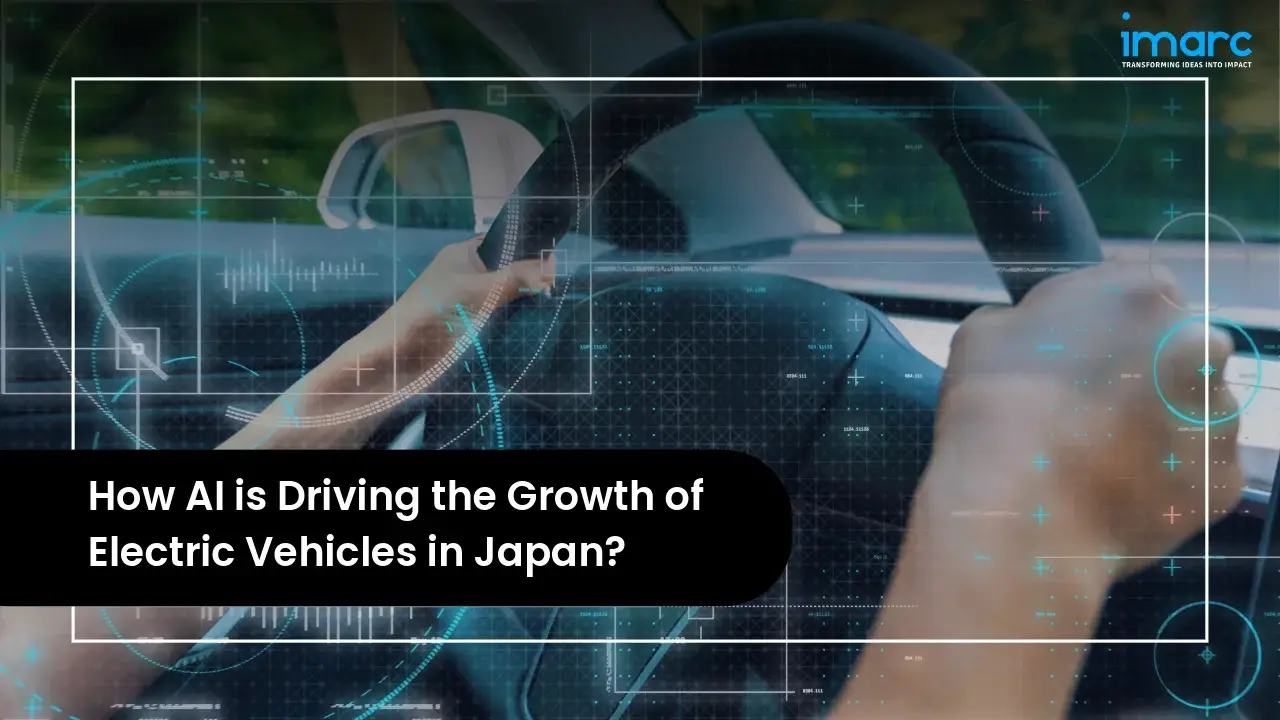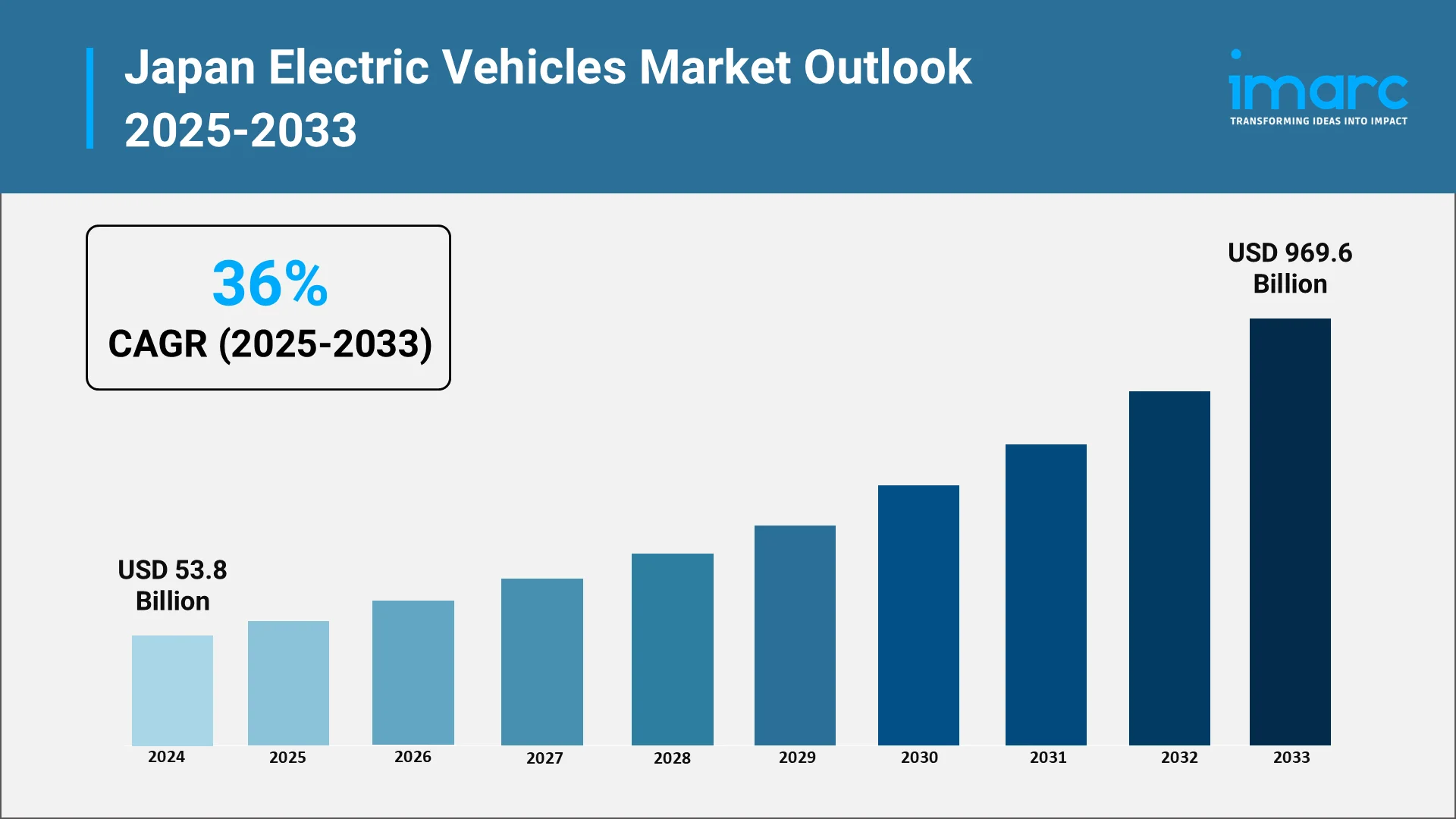How AI is Driving the Growth of Electric Vehicles in Japan?

Artificial intelligence (AI) is one of the most revolutionary forces currently shaping the world's automobile sector, and Japan's rapid adoption of electric vehicles (EVs) reflects this perhaps more than anywhere else. According to reports, the Japan electric vehicles market size reached USD 53.8 Billion in 2024. Looking forward, IMARC Group expects the market to reach USD 969.6 Billion by 2033, exhibiting a growth rate (CAGR) of 36% during 2025-2033. Moreover, as a place known for being at the forefront of technological advancement, Japan is using AI to improve the look, performance, infrastructure, and environmental integrity of electric motoring. Not only is AI transforming the production and maintenance of EVs, but it is also revolutionizing how they fit into urban environments, logistics systems, and consumer ways of life. The combination of AI and EVs is playing a pivotal role in Japan's path to a low-carbon society where efficiency, safety, and intelligence merge to form a genuinely modern mobility system.

Explore in-depth findings for this market, Request Sample
AI's Role in Shaping Japan's EV Landscape:
Growth and Innovation in the Japan Electric Car Market
- The electric car market in Japan has been on an upward trend, propelled by technological innovation, environmental concerns, and consumer demand for cleaner modes of transportation. AI is at the core of this transformation, facilitating innovation at each point along the value chain. In January 2025, Honda revealed its Honda Zero Saloon and Honda Zero SUV concepts with in-house Asimo operating system, with mass production set to begin in 2026. Furthermore, from design to deployment, AI allows manufacturers to optimize vehicle aerodynamics, forecast consumer demand, and incorporate adaptive systems enhancing safety and user experience.
- AI plays a crucial role in enabling connected features that enhance real-time decision-making. Navigation, collision avoidance, and adaptive cruise control are all enhanced by AI-based algorithms that learn from patterns and constantly optimize performance. Such flexibility is critical to Japan, where population density and road conditions require vehicles that are intelligent enough to function in dense traffic ecosystems. Thus, the Japan electric car market is being reshaped into one where vehicles are no longer static products but dynamic systems that evolve over time. According to reports, in May 2025, KG Motors launched its battery one-seater "Mibot" in Japan with a range of 100 km, five-hour charge, top speed of 60 km/h, and mass-market affordability.
AI’s Contribution to Smart Mobility and Urban Transport
- Japan's urban centers are beset by congestion, pollution, and sustainability problems, and these are being tackled by AI through smart mobility. In electric cars, AI allows smooth integration into overall urban transport systems. AI-equipped EVs can talk to traffic centers, optimize routes to mitigate congestion, and interact with public infrastructure for smoother travel. According to the reports, in February 2025, Nissan road-tested its autonomous car with various sensors and AI-powered navigation on congested city roads, demonstrating Japan's advancements toward driverless mobility to mitigate aging population and driver shortages.
- AI-powered vehicle-to-everything (V2X) communication ensures that EVs communicate not just with other cars but also with traffic signals, pedestrian infrastructure, and city utilities. EV’s thus become more than a means of transport—they become drivers of sustainable and efficient cities. Shared mobility platforms, ride-hailing fleets, and last-mile delivery fleets all benefit from AI and are increasingly dependent on electric powertrains in Japan.
Revolutionizing EV Infrastructure through AI:
AI-Driven Efficiency in the Japan Electric Vehicle Charging Station Market: A strong charging network is key to mass EV adoption, and AI is stepping up to make this system efficient and user-friendly. In July 2025, PowerX and Mercedes-Benz opened the first high-power EV charging hub in Chiba Park, Japan, with 150 kW output, 24/7 public access, and battery-integrated Hypercharger technology. Additionally, in Japan, AI integration in charge networks ensures optimal station location, optimal load distribution, and predictive demand management. Charging providers utilize AI algorithms to study traffic flow, population density, and consumer behavior to locate charging points strategically. In addition, AI enhances user experience through features such as dynamic pricing, real-time updates on availability, and customized charging advice. Through equilibrium of the requirements of single users with stability of the grid, AI helps the Japan EV charging station market keep up with the fast growth in EV ownership.
Predictive Maintenance and Energy Load Balancing: In addition to placement and availability, AI is also improving the durability of Japan's charging infrastructure. AI-powered predictive maintenance systems track equipment health and detect likely failures before they happen, minimizing downtime and maintenance costs. Likewise, AI-based energy load balancing prevents charging demand from overwhelming the grid, a critical consideration as EV volumes increase. By understanding consumption patterns, weather, and renewable energy inputs, AI can manage load flows smartly, easing the burden on power grids while maximizing the utilization of clean energy resources. This forms a clean-charging ecosystem that supports Japan's carbon neutrality aspirations.
Enhancing Performance with AI and Electric Motors:
Technological Advances in the Japan Electric Motor Market
- At the heart of all electric vehicles is the motor, and Japan has been at the forefront of motor technology for decades. AI builds on this strength by allowing more accurate design, testing, and performance tuning. Machine learning algorithms assist engineers in simulating performance under different conditions, minimizing trial-and-error cycles of development. In October 2024, U.S. startup Quadric and DENSO signed a development license agreement to co-develop in-vehicle AI semiconductors combining Chimera GPNPU and RISC-V IP for automotive use cases.
- In the Japan electric motor market, AI-driven control systems are improving torque efficiency, reducing heat loss, and enabling smoother acceleration. These refinements translate to greater driving range, better responsiveness, and a more reliable performance profile. With AI guiding motor design and operations, Japan is elevating the standard for EV drivability and long-term durability.
AI’s Role in Powertrain Optimization and Battery Management
- Motive power is vital, but the harmony between the powertrain and battery system characterizes the EV experience. AI enhances real-time power distribution optimization to ensure that motors are always running at optimal efficiency without prematurely depleting the battery. Advanced algorithms forecast energy demands on the basis of driving habits, road topography, and traffic conditions to make dynamic adjustments that maximize battery life.
- Battery management systems (BMS) are likely the most important recipients of AI. Advanced AI algorithms forecast charging cycles, avoid overheating, and predict degradation patterns. In doing this, they extend battery life while offering drivers reliable range estimations, mitigating one of the most persistent hindrances to EV adoption. According to reports, in March 2025, Enechange announced the installation of 77 EV Charge 6kW Level 2 charging ports in 20 Valor outlets in Japan's Tokai district, promoting EV convenience and decarbonization efforts.
The Impact of AI in Commercial EVs:
Smart Logistics in the Japan Electric Truck Market
- AI supports Japan's business EV truck operations by allowing for real-time monitoring, predictive load planning, and smart route calculation. AI is integrated with warehouse systems to streamline storage, transportation, and delivery schedules, minimize downtime, optimize energy usage, and provide reliable, environmentally friendly logistics services throughout Japan's intricate urban and regional supply chains.
Fleet Management and Route Optimization with AI
- AI revolutionizes fleet management by tracking vehicle condition, driver habits, and maintenance requirements, reducing expenses and raising efficiency. AI-driven route planning and autonomous delivery pilots enable fleets to travel maximum distance with minimum energy, improving performance in Japan's highly networked urban and semi-urban logistics system while leading the way in smart, networked commercial EV solutions.
AI throughout the EV Lifecycle and Support Ecosystem:
- Predictive Intelligence in the Japan Electric Vehicle Aftermarket: AI revolutionizes Japan's EV aftermarket by anticipating likely vehicle breakdowns before they happen. Through real-time analysis of component deterioration, charging habits, and atmospheric conditions, service providers are able to act proactively, minimize repair expenses, and improve vehicle reliability. The predictive treatment reinforces customer confidence and optimizes vehicle performance throughout the EV lifespan.
- Strengthening After-Sales Services with AI Analytics: AI-powered analytics allow Japanese EV service providers to provide customized after-sales services. From customized maintenance timetables to accurate forecasting of parts demand, AI enhances operational effectiveness and customer care. Intelligent chatbots, remote diagnosis, and virtual assistants offer real-time advice, reducing in person visits and increasing the convenience of vehicle servicing for Japan's tech-embracing EV owners.
Key Players Leading AI-EV Revolution in Japan:
Japanese Car Makers and Tech Startups Adopting AI
- Japan's electric vehicle industry is seeing artificial intelligence strategically integrated, both by legacy automakers and new startups. Legacy automakers like Toyota, Nissan, and Honda are integrating AI into car platforms, manufacturing lines, and logistics to enhance efficiency and performance. In July 2025, Nissan initiated discussions with Taiwan's Foxconn to make electric vehicles at its Oppama factory in Japan with a view to increasing local manufacturing, improving production efficiency, and boosting EV production. Furthermore, startups like Wayve, PlusAI, and Dexterity are developing autonomous driving technologies, predictive maintenance, and intelligent charging solutions. All these players collectively are building an AI-based ecosystem that goes beyond automobiles to include after-sales, mobility infrastructure, and energy management, further entrenching Japan's position as a world leader in next-generation electric mobility and smart transportation solutions.
Strategic Partnerships Driven by Innovation
- Collaboration has emerged as a key pillar of AI-powered EV development in Japan. Collaborations among automakers, tech companies, research institutions, and government agencies are promoting innovation along the entire value chain. From joint development of AI algorithms to trials of autonomous fleets, these collaborations enhance the development speed while disseminating the fruits of innovation across industries. According to reports, in early 2025, Waymo will start testing AI-driven Jaguar I-PACE robotaxis in Tokyo in partnership with Nihon Kotsu, the company's first international deployment of autonomous driving technology. Moreover, such partnerships also enhance Japan's global competitiveness by making sure that its EV sector is at par with the world in terms of international standards as well as export oriented.
Opportunities and Challenges for AI-Driven EV Growth:
Policy Support, Infrastructure Needs, and Consumer Adoption
- Government policy continues to play a crucial role in shaping the EV landscape. Supportive regulations, subsidies, and infrastructure investment create favorable conditions for AI integration in EVs. However, the pace of adoption also depends on consumer confidence, which is being strengthened by AI’s ability to enhance safety, convenience, and sustainability.
- Infrastructure requirements continue to be substantial, with special emphasis placed on making sure AI-driven charging infrastructures and power grids are capable of handling mass electrification. These investments are crucial to narrowing the gap between consumer consumption and technology capabilities.
Data Governance and AI Ethics in the Automotive Industry
- Although AI provides enormous advantages, it also brings with it concerns regarding data governance and ethics. Electric vehicles create vast amounts of data ranging from driving habits to location tracking and ensuring safe and ethical usage of the same is of utmost importance. Japan's strategy focuses on transparency, accountability, and consumer confidence.
- Balancing innovation with smart use of AI will ascertain the long-term success of this intersection. Ethical frameworks, regulation, and consumer education are all important to guarantee that AI boosts mobility without sacrificing privacy or security.
Future Outlook: AI and Japan's Electric Mobility Vision
The Road Ahead for Japan's AI-Powered EV Industry: Artificial intelligence is revolutionizing Japan's electric vehicle industry, making its cars safer, smarter, and cleaner. The future will see widespread deployment of autonomous EVs, integration with renewable energy sources, and smart infrastructure, making Japan a world leader in sustainable mobility and driving smart transportation systems that automatically adjust to changing city and environmental needs.
Long-Term Impact on Sustainability and Smart City Integration: AI-driven EVs propel Japan's sustainability and smart city vision through emissions reduction, energy efficiency optimization, and enhancement with renewable energy. Adoption furthers transportation, energy, and urban systems to create a digitally connected, green society and forge intelligent, inclusive, and efficient mobility that transcends traditional transport.
IMARC Group Insights: AI-Driven Change in Japan's Electric Vehicle Market
IMARC Group empowers Japanese electric vehicle market stakeholders with data-driven insights and strategic advice to leverage the power of AI in transforming the market. With AI-enabled vehicle systems, intelligent mobility, predictive maintenance, and intelligent charging infrastructure driving change, our reports empower clients to confront market trends and capitalize on prospects through:
- Market Intelligence: Review AI adoption in EV design, manufacturing, battery management, smart charging networks, and urban mobility infrastructure, as well as industry adoption by home and foreign automakers.
- Strategic Forecasting: Review long-term growth patterns, renewable energy use, autonomous vehicle deployment, and infrastructure optimization affecting Japan's EV market.
- Competitive Benchmarking: Track leading automotive makers, EV companies, and AI technology companies that are fueling innovation and establishing performance and sustainability benchmarks.
- Regulatory & Policy Mapping: Examine government incentives, EV infrastructure policy, environmental policies, and safety regulations affecting EV uptake and AI-based mobility solutions.
- Personalized Advisory: Provide implementable strategies for AI adoption, smart charging integration, fleet optimization, and eco-friendly mobility programs to achieve optimal efficiency and environmental returns.
Through the application of AI towards smart, connected, and green operations, IMARC Group helps customers lead the way in Japan's fast-changing electric vehicle space.
Our Clients
Contact Us
Have a question or need assistance?
Please complete the form with your inquiry or reach out to us at
Phone Number
+91-120-433-0800+1-201-971-6302
+44-753-714-6104
.webp)










